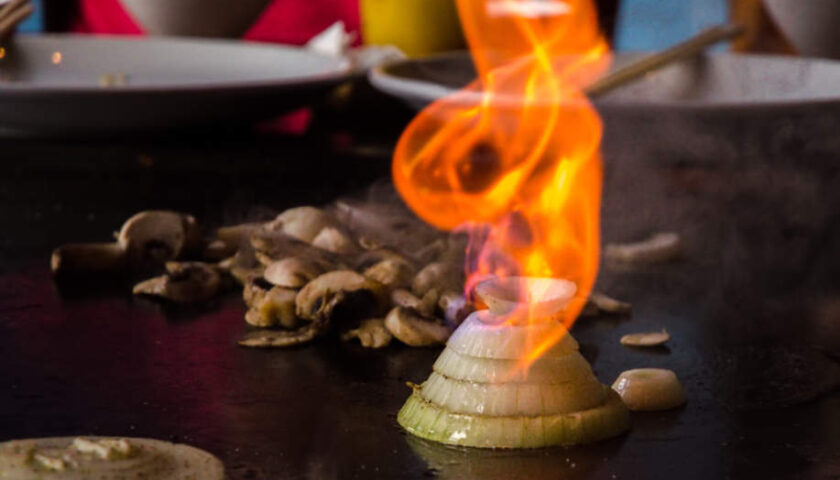
The Art of Japanese Cuisine: Teppanyaki vs. Hibachi
Japanese cuisine is renowned for its emphasis on seasonality, quality of ingredients, and presentation. Among its diverse culinary practices, teppanyaki and hibachi stand out for their unique flavors, cooking techniques, and dining experiences.
While both styles involve grilling food over an open flame, they are distinct in their methods, tools, and atmospheres.
At Wasabi Japanese Steakhouse in Novi, MI, guests can immerse themselves in the rich traditions of Japanese cooking and discover the subtle differences between these two popular styles.
The allure of Japanese cuisine, particularly through the lens of teppanyaki and hibachi, extends beyond mere cooking techniques to embody a cultural experience that engages all the senses.
These culinary practices offer more than just a meal; they provide a window into the meticulous care, artistic flair, and deep-rooted traditions that define Japanese gastronomy.
Teppanyaki, with its theatrical presentations and masterful display of culinary skills, captivates diners with a feast for the eyes as much as for the palate.
Meanwhile, hibachi brings the primal allure of fire and smoke to the forefront, highlighting the natural flavors of the ingredients through the simple yet profound act of grilling.
With Wasabi Japanese Steakhouse, every dish served is a testament to the harmony, precision, and respect for ingredients that Japanese cuisine is celebrated for, making each visit a memorable journey into the heart of Japan’s culinary artistry.
Understanding Teppanyaki
Teppanyaki is a post-World War II style of Japanese cuisine that uses an iron griddle to cook food. The word “teppanyaki” is derived from “teppan,” meaning iron plate, and “yaki,” which translates to grilled, broiled, or pan-fried.
In teppanyaki restaurants, chefs prepare dishes on a large, flat iron griddle right in front of guests, offering not only a meal but a performance.
The teppanyaki grill’s expansive surface is ideal for cooking a variety of foods, including:
• Steak
• Seafood
• Chicken
• Vegetables
• Rice
This method allows for a versatile dining experience, where the skillful maneuvers of the chef become part of the entertainment.
Wasabi Japanese Steakhouse, located in the heart of Novi, MI, prides itself on delivering an unforgettable teppanyaki experience, where guests can enjoy the culinary theatrics up close.

Exploring Hibachi
The term hibachi traditionally refers to a heating device rather than a style of cooking. It consists of a round, open-topped container, called a “fire bowl,” used to burn wood or charcoal, with a grate placed over it for cooking.
Unlike teppanyaki, hibachi cooking is often more intimate, with a focus on direct grilling over charcoal.
Wasabi Japanese Steakhouse offers a hibachi dining experience that combines the authentic flavors of Japanese grill with the flair of live cooking.
While hibachi in the United States might sometimes be electric to accommodate indoor settings, the essence of hibachi cooking—quick, high-heat grilling that imparts a smoky flavor to the food—remains unchanged.
Discover the differences between teppanyaki and hibachi to appreciate the unique qualities each brings to Japanese cuisine.
Key Differences Between Teppanyaki and Hibachi
While both teppanyaki and hibachi offer a glimpse into the rich tapestry of Japanese culinary arts, several key differences distinguish the two:
• Cooking Surface: Teppanyaki uses a flat, solid iron griddle, whereas hibachi employs a grill with an open grate design.
• Heat Source: Teppanyaki grills typically use propane, making them suitable for indoor use, while traditional hibachi grills are charcoal-fired.
• Food Presentation: Teppanyaki chefs often perform intricate cooking shows, making food preparation an interactive experience. Hibachi focuses more on the direct grilling technique, with less emphasis on performance.
• Menu Options: Teppanyaki menus tend to feature a wide range of meats, seafood, and vegetables, all cooked on the griddle’s surface. Hibachi menus might offer a similar variety but emphasize the smoky flavor characteristic of charcoal grilling.
At Wasabi Japanese Steakhouse in Novi, MI, guests can enjoy the best of both worlds, choosing between the theatrical teppanyaki counter and the cozy hibachi grill, depending on their mood and dining preferences.
The Cultural Significance of Teppanyaki and Hibachi in Japan
Both teppanyaki and hibachi are more than just cooking styles; they are expressions of Japanese culture and philosophy. The emphasis on fresh ingredients, meticulous preparation, and the communal aspect of dining reflects the Japanese approach to food as an art form and a shared experience.
Wasabi Japanese Steakhouse embraces these traditions, offering a slice of Japanese culture in Novi, MI.
Beyond merely serving food, teppanyaki and hibachi embody the Japanese values of harmony, respect, and minimalism, where every element from the ingredient selection to the final presentation is thoughtfully considered.
This deep-rooted respect for the culinary process and the diner’s experience is what makes dining at teppanyaki and hibachi establishments not just a meal, but a journey into the heart of Japanese culinary excellence.
Through these dining experiences, guests are invited to connect with the rich history and vibrant traditions that define teppanyaki and hibachi, making each dish a celebration of Japanese heritage.
Cultural Significance of Teppanyaki and Hibachi in The U.S.
In the United States, teppanyaki and hibachi have transcended their traditional Japanese roots to become a beloved part of American dining culture. These cooking styles have been embraced for their ability to turn a meal into an engaging experience, blending culinary skill with entertainment.
Restaurants like Wasabi Japanese Steakhouse in Novi, MI, have played a pivotal role in popularizing these Japanese cooking methods, offering a unique blend of showmanship and exquisite flavors that appeal to the American palate.
This fusion of cultures has not only introduced diverse culinary techniques to U.S. diners but has also fostered a greater appreciation for Japanese cuisine as a whole. As a result, teppanyaki and hibachi have become more than just dining options; they represent a cultural exchange that enriches the American culinary landscape, making every meal a memorable event.
FAQ
Can I find vegetarian options at teppanyaki and hibachi restaurants?
Yes, teppanyaki and hibachi restaurants are increasingly catering to the diverse dietary preferences of their guests, including vegetarians. These establishments typically offer a variety of vegetarian dishes that are just as flavorful and satisfying as their meat-based counterparts.
At teppanyaki restaurants, chefs can prepare an array of grilled vegetables, tofu, and rice or noodle dishes right on the griddle, using separate tools and areas of the grill to accommodate vegetarians. The interactive nature of teppanyaki also allows guests to customize their meals, ensuring that their vegetarian preferences are met with creativity and care.
Hibachi grills, with their focus on direct grilling, are also well-suited to vegetarian diets. Vegetables grilled over charcoal acquire a rich, smoky flavor that enhances their natural taste. Many hibachi restaurants offer vegetarian options that include a selection of grilled vegetables, tofu, and even vegetarian sushi rolls.
The intimate setting of hibachi dining ensures that chefs can cater to individual dietary needs, providing a delightful and inclusive dining experience for vegetarians.
How do I choose between a teppanyaki and hibachi restaurant?
Choosing between a teppanyaki and a hibachi restaurant often comes down to personal preference regarding the dining experience and flavor profiles you enjoy. If you’re looking for an interactive and entertaining meal where the preparation of your food is part of the show, teppanyaki is the way to go.
The lively performances by skilled chefs, combined with the opportunity to customize your meal as it’s being prepared, make teppanyaki an ideal choice for those seeking a dynamic dining experience.
On the other hand, if you prefer a more traditional and intimate setting where the focus is on the food’s flavor, especially the unique smokiness imparted by charcoal grilling, then a hibachi restaurant might be more to your liking. Hibachi offers a closer connection to the culinary traditions of Japan, with chefs focusing on the art of grilling over charcoal to bring out the depth and richness of the ingredients.
Ultimately, both teppanyaki and hibachi provide unique and memorable dining experiences that celebrate the diversity and richness of Japanese cuisine. Whether you’re drawn to the theatrical flair of teppanyaki or the authentic charm of hibachi, you’re sure to enjoy a meal that’s not only delicious but also a reflection of Japan’s culinary heritage.
What is the main difference between teppanyaki and hibachi?
The primary distinction between teppanyaki and hibachi lies in the cooking equipment used and the style of cooking. Teppanyaki is known for its use of a large, flat iron griddle that allows chefs to cook food in front of guests, offering a highly interactive and entertaining dining experience.
This method is conducive to a wide range of cooking techniques, from sautéing to grilling, and is ideal for preparing a variety of dishes simultaneously. The flat surface of the teppanyaki grill ensures even cooking and allows chefs to showcase their culinary skills, from flipping shrimp tails to creating intricate onion volcanoes.
In contrast, hibachi cooking is centered around a traditional Japanese charcoal grill, which provides a more intimate and authentic grilling experience. The charcoal used in hibachi grills imparts a distinct smoky flavor to the food, which is highly prized in Japanese cuisine.
Hibachi chefs often cook smaller portions directly over the open flame, allowing for precise control over the cooking process and resulting in a flavor profile that is deeply infused with the essence of the charcoal.
While hibachi may offer less in terms of theatrical presentation compared to teppanyaki, it makes up for this with the rich, smoky flavors that are characteristic of traditional Japanese grilling.
Can children enjoy the teppanyaki and hibachi dining experience?
bsolutely! Children are often fascinated by the live cooking performances at teppanyaki and hibachi restaurants. The interactive nature of the meal, with chefs performing tricks and engaging directly with guests, makes it a fun and memorable dining experience for young diners.
Many restaurants also offer kid-friendly menu options, ensuring that there’s something for every member of the family to enjoy.
How do I make a reservation at a teppanyaki or hibachi restaurant?
Making a reservation at a teppanyaki or hibachi restaurant is typically straightforward. You can call the restaurant directly, use their website if online booking is available, or utilize a third-party reservation service. Given the popularity of these dining experiences, especially on weekends and holidays, it’s advisable to book your table in advance to secure your spot and minimize wa
Wasabi Japanese Steakhouse in Novi, MI, is a premier destination for those looking to explore the rich flavors and traditions of Japanese teppanyaki and hibachi cuisine.
Whether you’re drawn to the dynamic flair of teppanyaki chefs or the authentic charm of hibachi grilling, Wasabi Japanese Steakhouse offers an unparalleled dining experience that celebrates the art of Japanese cooking.
